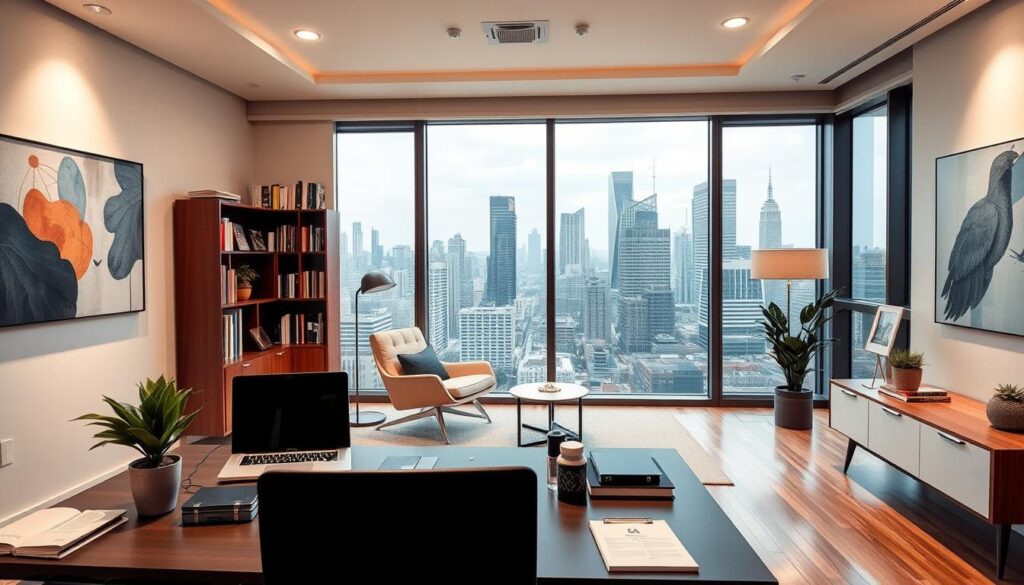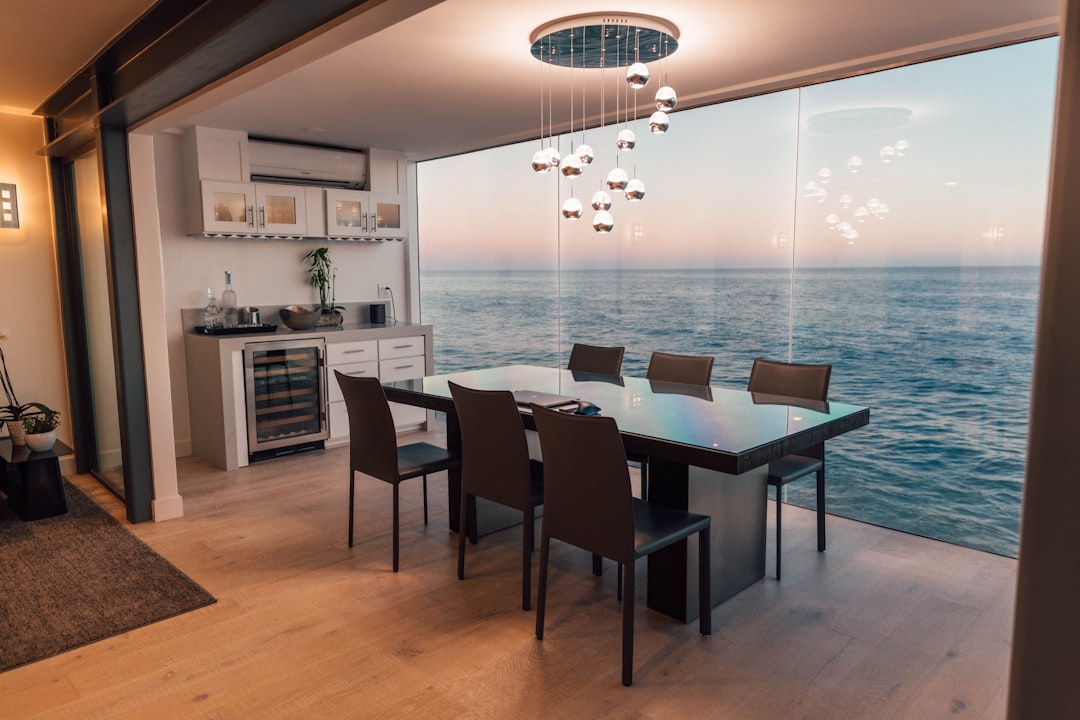The interior design industry is growing fast. The Bureau of Labor Statistics says there will be a 5% increase in employment opportunities for interior designers from 2020 to 2030.
Exploring interior design, we find many career paths. We’ll show you the different jobs in interior design. You’ll learn about the job market and what skills you need.
Key Takeaways
- Understanding the current job market for interior designers
- Identifying the required skills for success in the industry
- Exploring different types of employment settings
- Creating a standout portfolio to secure your dream job
- Navigating the interior design job market with confidence
Understanding the Interior Design Job Market
Getting to know the interior design job market is key for those starting or growing in this field. The market for interior designers changes due to the economy, new tech, and what people want.
Current Trends in Interior Design Employment
The interior design world is seeing big changes that affect jobs. Some key trends include:
- Sustainable design: Eco-friendly design is more wanted as people care more about the planet.
- Technological integration: Designers need to know about new tech like virtual reality and 3D printing.
- Wellness-oriented design: Spaces that help people stay healthy are becoming more popular.
These trends open up new chances for designers who can keep up with the changes.
Key Skills Required for Interior Designers
To do well in the interior design job market, designers need to have a mix of skills. They should be creative, tech-savvy, and good at working with people. Some important skills are:
| Skill Category | Specific Skills | Importance Level |
|---|---|---|
| Creative Skills | Design creativity, Color theory, Space planning | High |
| Technical Skills | Proficiency in design software (e.g., AutoCAD, SketchUp), Knowledge of building codes and regulations | High |
| Soft Skills | Communication, Project management, Client service | Medium |
By working on these skills, interior designers can improve their job chances and career growth in a tough market.
Types of Employment Settings for Interior Designers
The interior design world has many job options. You can work in residential design firms, commercial agencies, or as a freelancer. Knowing what each setting offers helps you choose the right path for your career.
Residential Design Firms
Residential design firms make homes for homeowners. Designers here focus on what clients like and need. They create spaces that are both beautiful and useful.
- Consulting with clients to understand their needs and preferences
- Creating design concepts and presenting them to clients
- Selecting materials, finishes, and furniture
- Overseeing the implementation of design plans
Working in these firms lets designers see how their work changes people’s lives. It’s great for those who love talking to clients and making homes that show off their personalities.
Commercial Design Agencies
Commercial design agencies design spaces for businesses. They think about the brand, how the space works, and how people will use it. Their jobs include:
- Developing design concepts that align with a company’s brand and culture
- Creating layouts that optimize space usage and workflow
- Selecting materials and finishes that meet durability and aesthetic requirements
- Collaborating with contractors and vendors to implement designs
Commercial design lets designers work on big projects. It’s perfect for those who like solving problems and making spaces that are both beautiful and practical.
Freelance Opportunities
Freelancing lets designers pick their projects and clients. Freelancers work on their own, handling everything from start to finish. The benefits are:
- Flexibility in choosing projects and clients
- Potential for higher earnings based on the projects undertaken
- Opportunity to diversify your portfolio by working on various types of projects
But freelancing also means you need to be good at business. You’ll need to market yourself, manage clients, and handle money. It’s for those who like being their own boss and working on their own terms.
In conclusion, the interior design field has many job options. Each setting has its own benefits and challenges. By understanding these, designers can choose the best path for their career.
Educational Requirements for Aspiring Interior Designers
Educational requirements are key for interior designers. To thrive in this field, a strong educational base is crucial.
There are many ways to learn for those wanting to be interior designers. Getting a degree in interior design or a related field is common.
Degrees and Certifications
Colleges and universities offer various interior design programs. These range from associate’s to bachelor’s and master’s degrees. Topics include design principles, color theory, and space planning.
The National Kitchen and Bath Association (NKBA) certification is highly valued. It can boost your job chances.
Certifications like the NKBA show your expertise and dedication. They also prove you’re up-to-date with industry standards. Other notable certifications include those from the American Society of Interior Designers (ASID) and the International Interior Design Association (IIDA).
Continuous Education and Workshops
The interior design field is always changing. New trends, technologies, and materials appear often. To stay competitive, designers must keep learning.
They can do this by attending workshops, seminars, and conferences. Online courses and webinars are also great options. Continuous learning improves technical skills and helps you network.
By staying informed, designers can offer fresh solutions to clients. This keeps them ahead in their interior design career positions.
Creating a Standout Interior Design Portfolio
In the world of interior design, a portfolio is key. It’s not just a collection of projects; it’s a career booster. A well-organized portfolio can greatly impact how employers see your skills. We’ll look at how to make your portfolio stand out and boost your chances of getting the job you want in interior design job listings.
Essential Portfolio Elements
A strong portfolio should show off your range and versatility. Here are key elements to include:
- Before-and-after photos of your projects to show transformation
- Detailed descriptions of your design process and decisions
- Testimonials from satisfied clients
- Examples of different design styles you’ve worked with
With these elements, you can make a portfolio that showcases your skills and experience. This makes you a more appealing candidate for interior design career opportunities.
| Portfolio Element | Description | Benefit |
|---|---|---|
| Before-and-After Photos | Visual representation of your work | Demonstrates your ability to transform spaces |
| Project Descriptions | Detailed explanations of your design choices | Highlights your thought process and expertise |
| Client Testimonials | Feedback from clients you’ve worked with | Builds credibility and trust with potential employers |
How to Showcase Style and Versatility
To stand out in the competitive interior design market, show your technical skills, style, and versatility. Here are some tips:
- Include a mix of residential and commercial projects
- Highlight your ability to work with different design styles and trends
- Use high-quality images and clear descriptions to tell the story of each project
By showing your style and versatility, you prove you can handle various design challenges. This makes you a valuable asset for any interior design firm.
Networking in the Interior Design Industry
In the competitive world of interior design, networking is key to career growth. It helps you connect with professionals, stay updated on trends, and find job openings. This can greatly boost your career.
Professional Associations to Join
Joining professional groups is a smart move. The American Society of Interior Designers (ASID) is a great example. It offers exclusive events, educational materials, and networking chances.
- Opportunities to attend conferences and seminars
- Access to industry publications and research
- Networking events with industry professionals
Other groups like the International Interior Design Association (IIDA) and the National Kitchen and Bath Association (NKBA) are also worth joining. They help you meet others in your field and keep up with trends.
| Association | Benefits | Events |
|---|---|---|
| ASID | Networking, Education, Advocacy | Annual Conference, Design Days |
| IIDA | Professional Development, Networking | NeoCon, IIDA Awards |
| NKBA | Education, Design Competition | NKBA Design Week, Kitchen and Bath University |
Importance of Networking Events
Networking events are vital for building and keeping professional ties. They offer a chance to meet potential employers, partners, and mentors.
Some key benefits of attending these events include:
- Learning about the latest industry trends and technologies
- Showcasing your work and portfolio
- Establishing connections with industry leaders
By taking part in networking events and joining professional groups, you can increase your visibility and credibility. This can lead to more employment opportunities for interior designers.
The Role of Internships in Interior Design Careers
Internships are key for becoming a top interior designer. They let you use what you’ve learned in real situations. This boosts your skills and helps you meet people in the field.
Internships are more than just extra work. They’re a big part of learning to be an interior designer. Jane Smith, a famous designer, says, “Internships give you hands-on experience that classrooms can’t match.”
“They let you test your skills, learn from pros, and start building a network for jobs.”
Finding the Right Internship Opportunities
Finding the right internship is key. Look for ones that match your career dreams. Check out internships in homes, offices, and with freelance designers. Here’s what to look for:
- Choose internships with real work and projects.
- Look at the firm’s or designer’s reputation.
- See if they offer mentorship and feedback.
By picking the right internship, you’ll get valuable experience. This makes you stand out in the interior design job openings world.
Benefits of Real-World Experience
Internships offer priceless real-world experience. They improve your portfolio and show you what the job is like every day. Many designers get jobs right after their internships because they show they can do the work.
Internships also boost your soft skills like talking, working with others, and solving problems. These skills are crucial for success in interior design. As the field changes, internships become even more important.
In short, internships are essential for a good interior design career. They give you real-world experience, making it easier to find interior design job openings.
Job Search Strategies for Interior Designers
Finding a job in interior design needs a mix of strategies. This includes using top job boards and making your applications stand out. We’ll look at how to find career options for interior designers and the best ways to get noticed by employers.
Effective Job Boards and Platforms
Today, many job boards and platforms focus on interior design. Sites like Houzz, indeed, and LinkedIn are key for job opportunities in interior design. They list jobs and let designers show their work and connect with others.
| Platform | Description | Benefits |
|---|---|---|
| Houzz | A comprehensive platform for interior design professionals to showcase their work and find job opportunities. | Extensive portfolio showcase, job listings, and professional networking. |
| indeed | A widely used job search engine that aggregates interior design job listings from various sources. | Wide reach, resume upload, and job alert features. |
| A professional networking site that allows interior designers to connect with peers, share their work, and find job opportunities. | Professional networking, job listings, and personal branding opportunities. |
Tailoring Applications for Success
When applying for interior design jobs, tailor your application materials. Customize your resume and cover letter to match the job’s needs. This way, you can stand out in a crowded job market.
To tailor your applications well, follow these steps:
- Read the job description carefully to know what the employer wants.
- Emphasize relevant experience and skills in your resume and cover letter.
- Use the job posting’s language in your application materials.
By using these strategies and the right job boards, interior designers can improve their job search. Whether you’re starting or looking to grow, a well-planned job search is crucial for reaching your goals.
Keeping Up with Industry Changes
To stay ahead in the interior design job market, you need to watch the latest trends and tech. The industry keeps changing, so professionals must adapt and grow.
Following Design Trends
Design trends change fast, thanks to culture, society, and economy. It’s key to keep up with these changes through design resources and industry publications. For example, vintage styles and green materials are becoming more popular.
“The key to success in interior design is not just to follow trends but to anticipate them.” This way, designers can offer unique and fresh ideas to clients.
Adapting to Technology in Design
Technology has changed the interior design world, from 3D models to virtual reality. It’s important to use these tools to stay competitive in the interior design employment prospects. For instance, software can help create detailed designs and presentations, making client communication better.
“Technology is not just a tool; it’s a catalyst for creativity and innovation in interior design.”
By using technology, designers can try new things, work more efficiently, and give clients what they want.
- Stay updated with the latest design software and tools.
- Participate in workshops and webinars to enhance skills.
- Engage with professional networks to share knowledge and best practices.
Advancing Your Career in Interior Design
To move up in interior design, knowing the career paths is key. We can explore different ways to improve our skills and find new opportunities for growth.
Opportunities for Specialization
Choosing a special area in interior design can really help our career. We might look into sustainable design, universal design, or historic preservation. This way, we stand out and attract clients who need our unique skills.
For example, sustainable design is getting more popular. Getting a LEED AP certification shows we care about the environment. It makes us more credible in our field.

Leadership Positions in Design Firms
Going for leadership roles is another way to grow. Jobs like Creative Director, Design Director, or CEO are possible with the right experience. These roles come with better pay and the chance to shape the company’s future.
To get these jobs, we need design skills, business knowledge, and leadership abilities. We can learn these by taking courses in business, marketing, and leadership. Also, gaining experience in managing teams and projects is important.
By understanding the options for specialization and leadership, we can plan a career path that fits our goals. This way, we can make a real impact in the interior design world.
Conclusion: Securing Your Dream Job in Interior Design
Exploring interior design jobs shows us that success comes from skills, knowledge, and hard work. Looking for interior design jobs and keeping up with new listings helps you stay ahead. It’s all about finding the right fit for your career.
Growth Opportunities
Growing in your career is key in interior design. Keep learning and updating your skills to succeed. Stay current with design trends and new technologies.
Staying Motivated
It’s important to stay motivated while looking for jobs. Networking, making a strong portfolio, and customizing your applications can help. These steps can increase your chances of landing your dream job.



